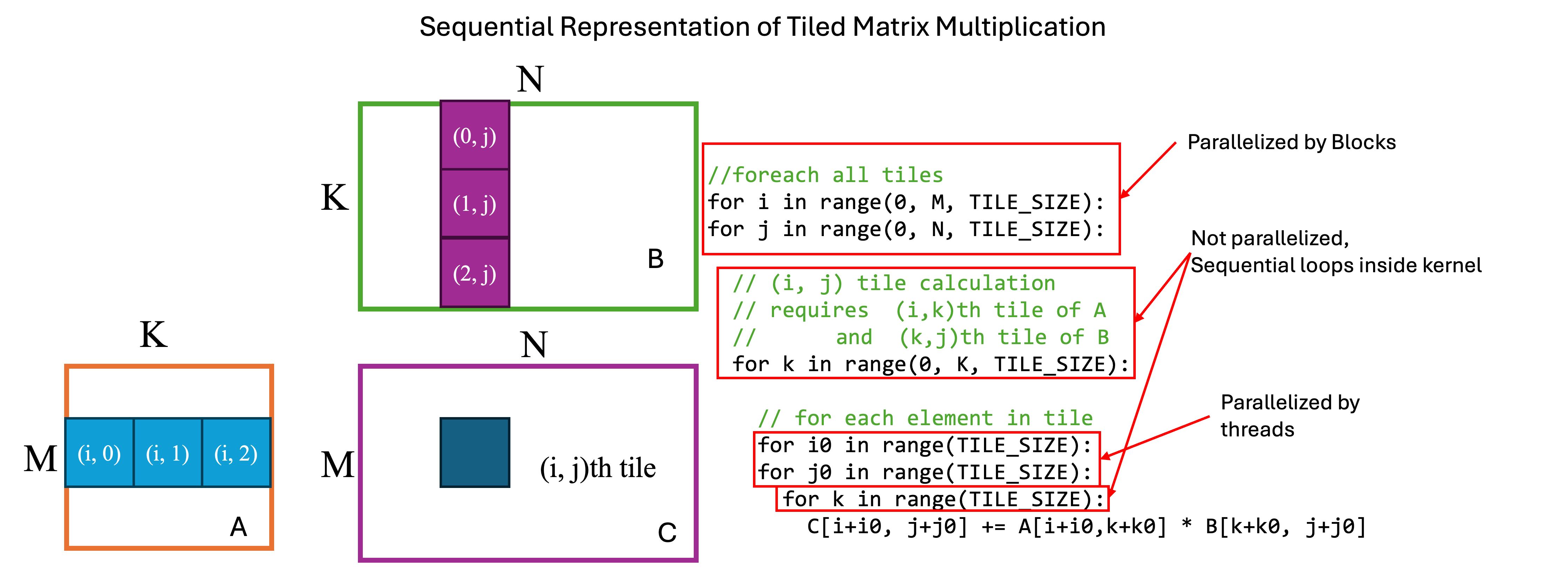I’m extremly poor at thinking about matrices. I’ve seen many people graphically think and draw matrix strides, multiplications, etc…. Yet as a person who work in ML, I think I should understand matmul, even in high-level concepts. This post is about my struggle to understand matmul in HPC environment.
for convenience, I set the notation:
- A is M by K sized matrix
- B is K by N sized matrix
- C = A @ B, is M by N sized matrix
Loops 1
for i in range(M):
for j in range(N):
for k in range(K):
C[i][j] += A[i][k] * B[k][j]
Note that we change the order of for loop. The result is same.
Loops 2
for k in range(K):
for i in range(M):
for j in range(N):
C[i][j] += A[i][k] * B[k][j]
Or, we can unroll the loop as we want.
Loops 3
for i in range(M, 16):
for i0 in range(16):
for j in range(N, 16):
for j0 in range(16):
for k in range(K, 16):
for k0 in range(16):
C[i][j] += A[i][k + k0] * B[k + k0][j]
We can just reorder this loops again;
Loops 4
for i in range(M, 16): # Two loops are parallelized
for j in range(N, 16): # by grids
for k in range(K, 16): # Not parallelized
for i0 in range(16): # Two loops are parallelized
for j0 in range(16): # by blocks
for k0 in range(16): # Not parallelized
C[i][j] += A[i][k + k0] * B[k + k0][j]
This Loops 4 form is what we want, Slightly different image showing same procedure in sequential manner.
- We can parallelize loops not involving k, and k0.
- first two loops having i, j can be parallelized by Grids
- i0, j0 loops are parallelized by Blocks
- We can tile
A[i:i + 16][k * 16:(k + 1) * 16], andB[k*16:(k+1) * 16][j:j + 16]and store them to the shared memory
Visualized figure is given below;

Cuda implementation is given below;
__global__ void matmul_smem(int *A, int *B, int *C, int M, int K, int N) {
__shared__ int tile_A[16][16];
__shared__ int tile_B[16][16];
int i = blockIdx.x * blockDim.x; // Grid parallelizing i (rows)
int j = blockIdx.y * blockDim.y; // Grid parallelizing j (columns)
int i0 = threadIdx.x;
int j0 = threadIdx.y;
int sum = 0;
for (int k = 0; k < K; k += 16) { // Tiling over K dimension
// Load A's tile into shared memory
if (i + i0 < M && k + j0 < K)
tile_A[i0][j0] = A[(i + i0) * K + (k + j0)];
else
tile_A[i0][j0] = 0;
// Load B's tile into shared memory
if (j + j0 < N && k + i0 < K)
tile_B[i0][j0] = B[(k + i0) * N + (j + j0)];
else
tile_B[i0][j0] = 0;
__syncthreads();
// Perform computation within the tile
for (int k0 = 0; k0 < 16; k0++) { // Iterate over tile's K dimension
sum += tile_A[i0][k0] * tile_B[k0][j0];
}
__syncthreads();
}
// Write the result to C
if (i + i0 < M && j + j0 < N) {
C[(i + i0) * N + (j + j0)] = sum;
}
}
Conclusion
I’ve struggled but finally I grasped one of the most important idea in HPC computing…!